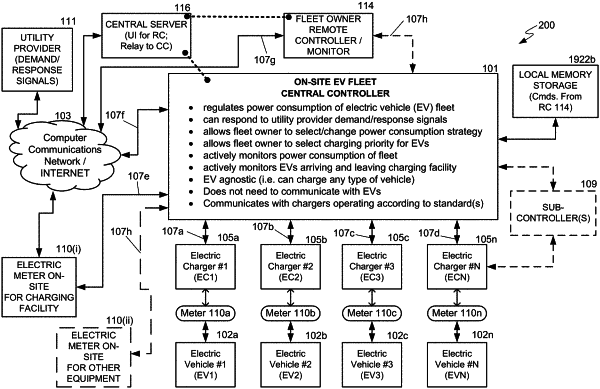| CPC B60L 53/62 (2019.02) [B60L 2200/10 (2013.01); B60L 2200/12 (2013.01); B60L 2200/18 (2013.01); B60L 2200/26 (2013.01); B60L 2200/32 (2013.01); B60L 2200/36 (2013.01); B60L 2200/40 (2013.01)] | 16 Claims |

|
9. A computer-implemented system for charging an electric vehicle fleet comprising:
a remote controller coupled to a central controller;
a plurality of chargers for charging the electric vehicle fleet, each charger supporting charging for a single electric vehicle, the central controller being positioned in proximity to the plurality of chargers and being in communication with the plurality of chargers, the remote controller existing remote and independent relative to the central controller and relative to the plurality of chargers;
the central controller receiving from the remote controller a selection of at least one of a first charging strategy and a second charging strategy, the first charging strategy comprising a focused charging strategy for a portion of the electric vehicle fleet that is coupled to the chargers, the second charging strategy comprising a semi-level charging strategy for charging an entirety of the electric vehicle fleet that is coupled to the chargers; the central controller determining a charge priority index value for each charger connected to an electric vehicle, the charge priority index value addresses a sequence in which chargers are turned on relative to each other and a sequence in which charge levels of chargers are increased relative to each other; the central controller determining a charge intensity value that is associated with a total number of vehicles needing charging and that are connected to the chargers, the charge intensity value that corresponds with being dependent on a magnitude of the total number of vehicles, and the charge intensity value also being dependent on the selected charging strategy;
when the first charging strategy is received by the central controller and depending upon the charge intensity value and charge priority index value determined for each charger, the central controller changes a state for chargers associated with the portion of the electric vehicle fleet having a higher priority index value are turned on first relative to chargers having a lower priority index value, and chargers turned on having a higher priority index value have charge levels increased faster relative to chargers turned on having a lower priority index value; when the second charging strategy is received by the central controller and depending upon a comparison between the charge intensity value and charge priority index value for each charger, the central controller turns on each charger at its lowest charge level, and as the charge intensity value increases, the central controller increases a charge level for each charger.
|